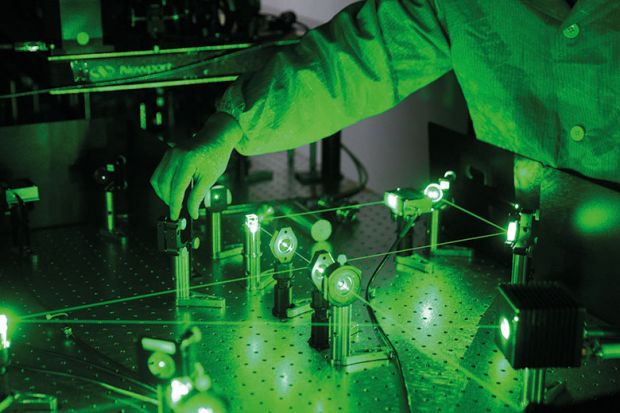Browse the full results of the World University Rankings 2020
Around the world, a race is under way to develop the revolutionary potential of quantum engineering and technology.
This global quantum race has a healthy element of urgency and even national rivalry, but it will also require an extremely high level of international cooperation and collaboration spanning universities, government and industry. The opportunities for working together across borders will be immense in the coming years and global research institutions that are developing strengths in quantum engineering should start seizing those chances now.
Quantum engineering has the potential to be one of the most transformative technologies of the next half-century. This new field of applied science harnesses the strange rules of quantum mechanics that govern nature’s smallest particles. We are learning to exploit these quantum peculiarities, such as particles that exist in two states at the same time or remain entangled across long distances, to develop entirely new kinds of devices, materials and computing techniques.
One of the areas being watched closely by international observers is the potential to use quantum communication channels to transmit encoded messages that are effectively unbreakable – a use with clear national and global security implications. The construction of a communications network based on quantum states of matter offers a fundamentally new way to create and securely send information. Many of the other applications of quantum engineering have relevance for consumers. The uses include advanced medical imaging, uniquely powerful computers able to tackle new kinds of problems and sensors that could anticipate earthquakes before they strike.
Because this is such a promising new field of applied science, national governments around the world are devoting substantial resources to building a skills base and infrastructure for quantum research. The nations making strides include China, which in 2016 launched the first quantum satellite, providing proof of principle for new techniques of making virtually unhackable communication networks. Australia, the Netherlands and the UK also are very much in the hunt, and the US is launching a new National Quantum Initiative with the intention of building leading quantum centres.

But there’s a catch for this rapidly progressing work. Building deep expertise in the field is difficult for individual institutions, in part because quantum engineering is such a new concept and requires extensive resources and a sophisticated technological base spanning disciplines. Because the field is growing so quickly, quantum experts are few and in high demand.
These are some of the reasons why a global, hub-based approach to quantum research holds such promise. The cross-pollination that comes from bringing together engineers from different institutions is especially helpful when many individual programmes are just getting started.
That’s also a major reason why we founded the Chicago Quantum Exchange, a multi-institutional, public-private collaboration designed to advance the science and engineering of quantum information.
Rather than serving a single institution, the CQE is built around the idea that bringing together insights from public and private universities, federally funded laboratories and technology companies can help this young field achieve a critical mass and develop a new quantum workforce that will benefit our region as well as collaborators around the globe. The founding members are the University of Chicago, the University of Illinois at Urbana-Champaign, and Illinois’ two US Department of Energy national laboratories – Argonne National Laboratory and Fermi National Accelerator Laboratory. Since 2017, the CQE has grown to include academic members Northwestern University and the University of Wisconsin-Madison, and corporate partners that see vast potential in this field – IBM, Boeing, Applied Materials, ColdQuanta, HRL Laboratories and Quantum Opus.
Taken as whole, the initiative is bringing together hundreds of highly skilled scientists and engineers who, by collaborating on common objectives, are uniquely positioned to develop the quantum technologies of the future. Last year, we announced the development of one of the world’s longest experimental quantum network links, using fibre optic cable to connect distant quantum systems 30 miles apart between Argonne and Fermilab.
The involvement of industry is crucial, as the member companies bring in private investment in student education, research and technology development. Such corporate partners greatly value the potential to train a new kind of workforce of quantum information experts, with perspectives attuned to the novel approaches of quantum engineering.
The chance to help build such a wide-ranging foundation for quantum industry and research innovation has attracted active government interest. The state of Illinois recently approved a total of $200 million (£165 million) in capital support for the CQE, with the University of Chicago committing an additional $100 million. The federal government has shown interest in supporting similar efforts with the December 2018 passage of the National Quantum Initiative Act. This act directs the US Department of Energy, the National Science Foundation and the National Institute of Standards and Technology to establish national centres in quantum information science to conduct basic research and education to accelerate quantum breakthroughs over the next 10 years.
At the same time, we see colleagues in other countries, such as the Netherlands and Australia, taking similar steps. In Australia, the Centre for Quantum Computation and Communication Technology (CQC2T) is drawing together universities from Australia and other nations, as well as an array of corporate partners. The Dutch initiative QuTech is having an impressive impact in developing prototype quantum computers and quantum networks along with select industrial partners.

We see these international quantum hubs as a spur to competition, but also as valued potential partners. By connecting across borders we can further build the global education and research pipeline. For example, once regional and national quantum networks show proof of concept, additional technology will be required to build a global quantum communication infrastructure. With such efforts, in the future, it’s likely that just as individual schools have particular specialties, nations will contribute to the quantum frontier in distinct ways through the talent and infrastructure that they develop. International collaboration will bring possibilities for innovation that no nation would have on its own.
Imagine our quantum future as a long foot race in which the competitors also help each other along the way. Such an outlook presents a rare opportunity for scientific and technological advancement that moves economies forward and benefits societies around the world.
David Awschalom is Liew family professor at Pritzker School of Molecular Engineering, University of Chicago; senior scientist at Argonne National Laboratory; and director at Chicago Quantum Exchange.
Register to continue
Why register?
- Registration is free and only takes a moment
- Once registered, you can read 3 articles a month
- Sign up for our newsletter
Subscribe
Or subscribe for unlimited access to:
- Unlimited access to news, views, insights & reviews
- Digital editions
- Digital access to THE’s university and college rankings analysis
Already registered or a current subscriber? Login







